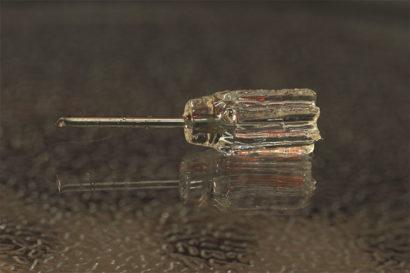- FMA
- The Fabricator
- FABTECH
- Canadian Metalworking
Our Publications
Categories
- Additive Manufacturing
- Aluminum Welding
- Arc Welding
- Assembly and Joining
- Automation and Robotics
- Bending and Forming
- Consumables
- Cutting and Weld Prep
- Electric Vehicles
- En Español
- Finishing
- Hydroforming
- Laser Cutting
- Laser Welding
- Machining
- Manufacturing Software
- Materials Handling
- Metals/Materials
- Oxyfuel Cutting
- Plasma Cutting
- Power Tools
- Punching and Other Holemaking
- Roll Forming
- Safety
- Sawing
- Shearing
- Shop Management
- Testing and Measuring
- Tube and Pipe Fabrication
- Tube and Pipe Production
- Waterjet Cutting
Industry Directory
Webcasts
Podcasts
FAB 40
Advertise
Subscribe
Account Login
Search
Researchers devise no-layers additive manufacturing process
UC Berkeley team develops 3D printer that relies on light to transform polymers into complex solid objects
- February 4, 2019
- Article
- Additive Manufacturing

The UC Berkeley 3D printer works by shining changing patterns of light through a rotating vial of liquid. A computer algorithm calculates the exact patterns of light needed to shape a specific object.
The speed, geometry, and surface-quality limitations of additive manufacturing processes are linked to their reliance on material layering, say researchers at UC Berkeley who’ve developed a new method for 3D-printing parts.
Instead of building layer upon layer, the Berkeley AM method concurrently prints all points within a 3-dimensional object by illuminating a rotating volume of photosensitive material with a dynamically evolving light pattern. (Click here to read a story The Additive Report posted about another “all-at-once” 3D printer developed at Lawrence Livermore National Laboratory.)
According to the Berkeley researchers, their method, Computed Axial Lithography (CAL), allows “us to synthesize arbitrary geometries volumetrically through photopolymerization.”
The CAL manufacturing device, nicknamed “Replicator” by the inventors, selectively solidifies a photosensitive liquid within a contained volume. Light energy is delivered to the material volume as a set of 2-dimensional images. Each projected image propagates through the material from a different angle. The superposition of exposures from multiple angles results in a 3-dimensional energy dose sufficient to solidify the material in the desired geometry. CAL also is scalable to larger print volumes, and reportedly is several orders of magnitude faster than layer-by-layer methods.
With CAL, the researchers can print features as small as 0.3 millimeter in acrylate polymers, as well as print soft structures with exceptionally smooth surfaces using gelatin methacrylate hydrogel.
Printing 3D structures around pre-existing solid components is possible with Replicator, too, and the team has used the printer to create a series of objects, including a tiny model of Rodin’s “The Thinker” and a customized jawbone model. Currently, the device can make objects up to 4 inches in diameter.
The technology has the potential to transform how products, from prosthetics to eyeglass lenses, are designed and manufactured, the researchers say.
“I think this is a route to being able to mass-customize objects even more, whether they are prosthetics or running shoes,” said Hayden Taylor, assistant professor of mechanical engineering at UC Berkeley and senior author of a paper describing the printer. “The fact that you could take a metallic component or something from another manufacturing process and add on customizable geometry, I think that may change the way products are designed,” Taylor said.
Information used in this report was excerpted from a news story posted to the UC Berkeley website and the journal Science.
About the Publication
- Podcasting
- Podcast:
- The Fabricator Podcast
- Published:
- 04/16/2024
- Running Time:
- 63:29
In this episode of The Fabricator Podcast, Caleb Chamberlain, co-founder and CEO of OSH Cut, discusses his company’s...
- Trending Articles
- Industry Events
16th Annual Safety Conference
- April 30 - May 1, 2024
- Elgin,
Pipe and Tube Conference
- May 21 - 22, 2024
- Omaha, NE
World-Class Roll Forming Workshop
- June 5 - 6, 2024
- Louisville, KY
Advanced Laser Application Workshop
- June 25 - 27, 2024
- Novi, MI



























